PIKE BROS., FAYLE & CO. LTD – The Production of Pike Fayle Clays
(An unedited textbridge and jpeg file copy of their brochure produced in the 1950s)
We have pleasure in presenting a further edition of our Brochure which has been carefully revised and extended, and which we believe will assist the ceramic industry in using our ball clays to the best advantage.
The Company has been producing Ball Clay in the Isle of Purbeck continuously for 200 years. During this time, there has been a steady accumulation of knowledge which has been used to improve the quality and output of our clays. Scientific and engineering progress has been recognised and adopted whilst retaining the craftsmanship, skill and tradition acquired over the long period of the Company’s existence.
In the ensuing notes we set out the means whereby this is achieved giving a brief sketch of the various factors involved in production on a modern Ball Clay works.

GEOLOGY
Ball clay, believed to be Eocene in origin, is found in Dorset in the Bagshot beds of sand and clay which lie between the hills bordering the north and south side of Poole Harbour. The Company has operating rights over some forty square miles of this deposit mainly situated in the southern half of the clay-field. Here clays of the finest grain size, and consequently greatest plasticity are to be found. The tranquil conditions necessary for the deposition of such fine particle clays generally result in a very even distribution throughout any given seam. Usually two or three clay seams are found together, deposited in veins which form amorphous lenses each of several acres in extent and varying between 15 to 50 feet in thickness. These lenses lie at any angle to the surface and are covered by anything from 10 to 200 feet of sand and loam overburden. It is therefore necessary to find the clay by exploratory (wildcat) boring in the first instance.
PROSPECTING
We have always led the industry in our methods of proving deposits and establishing, long before production is contemplated, the quality of the clays which theycontain. The old method of sampling each foot of clay is continued, but is speeded up by replacing hand-boring rigs with mechanical equipment. The assurance of continuity of supply by the proving of large reserves of clay well ahead of requirements, is of vital importance to every user, whether large or small, and it is a matter which has our close attention.
PRODUCTION
About four-fifths of the Company’s production is obtained by underground mining. The mines are on a substantial scale, and for many years have been planned and developed by qualified mining engineers. Mines plans exist for workings over the past hundred years, so that detailed knowledge of the nature and extent of various workings is readily ascertainable. Whether the clay is mined or open-cast, it is hand selected in the working face and dug with pneumatic spades. If more than one grade is present in a working face the greatest care is taken to see that exact separation is always achieved. We are convinced that hand digging and selection of ball clay is fully justified due to the folded and faulted nature of many veins of clay. Great care is taken to ensure that clay getters both on the surface and underground are fully aware of their responsibilities and they are well trained in selection. The various grades of clay so gotten are visually checked once more at the pit
head.
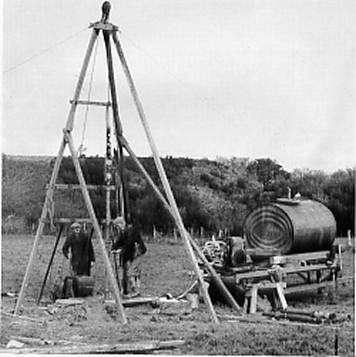
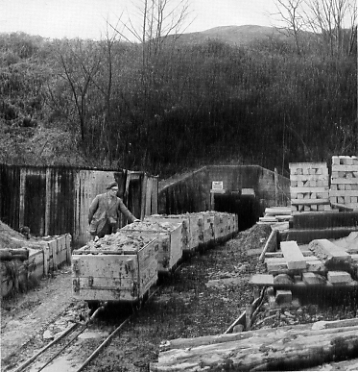
STORAGE AND PROCESSING
Clays are brought by lorry from the pits and mines to a central storage and processing works at Furzebrook. At the weighbridge the clay undergoes another visual check, and any clay suspected of variation is sampled for special check and set apart. Regular routine working face samples are also taken here. Storage capacity for some 10,000 tons under cover enables adequate stocks of all grades of clay to be maintained in lump, or shredded form. Fixed and portable machines are installed so that clay can be processed by shredding, blending, drying and granulating, powdering, air floating and artificial weathering. Special processing for individual users is carried out, but in no instance is clay chemically adulterated. A large clean layout makes possible prompt despatch by either road or rail. All lorries arriving to load for customers are inspected by the despatch foreman, and if necessary, the high pressure washing plant installed for the Company’s internal transport system is available to them. All railway wagons are thoroughly scrubbed clean, and whenever possible a closed circuit wagon system is used.
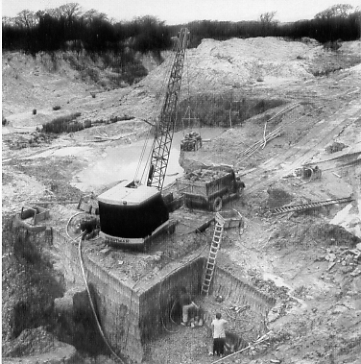
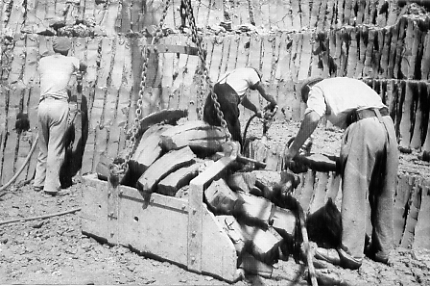
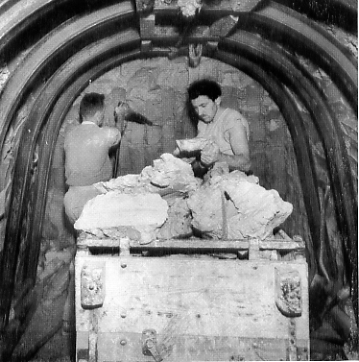
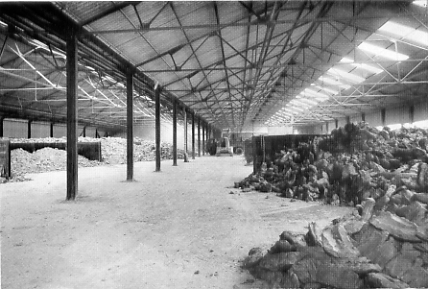
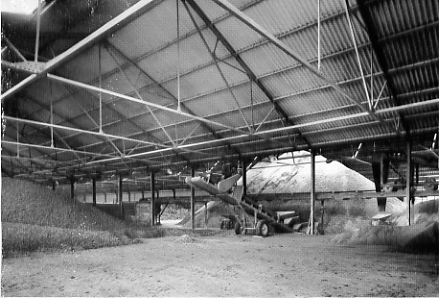
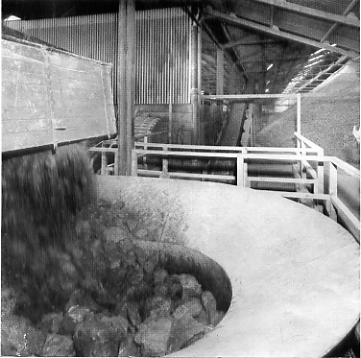
TESTING AND CONTROL
Routine physical testing of ball clays is of ever increasing importance; in fact, the bulk of our control tests come within this category. Very careful consideration has been paid to the practical significance of these tests and the time involved. The following outline of the control measures in operation by our Company will enable customers to appreciate the amount of care taken in the selection and separation of clays.
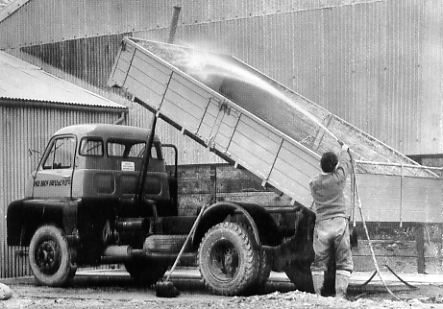
As already mentioned, boring rigs are continually in operation, prospecting for new deposits and confirming present ones. The samples obtained are thus months and sometimes years ahead of anticipated working. Thus there is ample time to ensure that full chemical and physical data is obtained. Routine control of the clay being worked is carried out by a system of preliminary
and comprehensive testing, and is applied on a batch basis to the various clays. Preliminary testing is designed to cover a series of rapid tests to check regularity before processing the clay; these tests cover fluid properties, plastic limit, plastic to dry volume contraction, ignition loss, silica content and wet sieve residue—per-centage and type. Comprehensive testing covers thermal expansion (reversible and irreversible) strength dried and fired, fired contraction, appearance and porosity. Such work is carried out regularly to maintain exact standards of clays for the industries we serve.
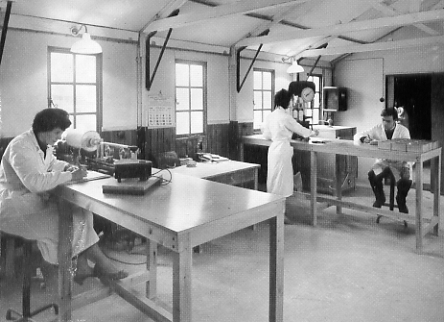
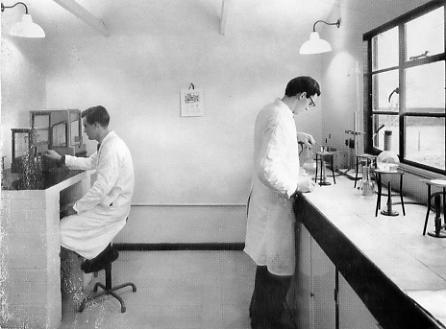
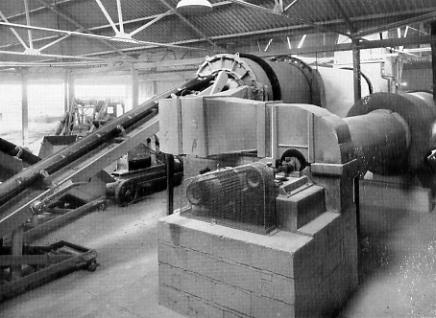
Control of clay is made completely effective by the co-operation of the mining and laboratory staff over the interpretation of laboratory results. The laboratory is able and willing to undertake research on behalf of users regarding the use and behaviour of ball clays.
Mineralogy and Properties of Dorset Ball Clays
It is generally accepted that the essential constituent in ball clay is that matter which, for want of a better description, is called clay substance, and is of kaolinitic structure; in addition, ball clay contains numerous other minerals in various proportions. Apart from clay substance, the minerals of main importance are quartz, mica and anatase.
It was a general belief that felspar is invariably present in ball clay, but X-ray examination has so far failed to confirm this. It is therefore now assumed that the alkalies are present in the form of mica.
The Dorset clay field contains some of the finest grained ball clays in the world, in most of which 90 per cent. of the particles are less than 1 micron equivalent spherical radius. The quartz and titania bearing minerals are concentrated in the coarser fractions whilst the mica, clay substance, and iron bearing minerals are in the finer fractions.
The colloid content of a clay is of the utmost importance, influencing both the fluid and plastic properties. According to Freundlich the value of 0-25 microns spherical radius is the upper limit for colloidal material hence we find that Dorset Clays range from 90 to 30 per cent. colloidal material, depending largely on the silica content of the clay concerned. Technical details such as this confirm, what the practical potter has known for generations, that Dorset Ball Clays are unrivalled for bonding power and strength.
In general Dorset clays are comparatively free from lignite, and although in con-sequence they require a little more alkali for maximum deflocculation, they are not subject to the variation in fluid properties usually associated with carbonaceous clays. In addition, having greater drying time, they impart elasticity in the mould and in consequence reduce very considerably any tendency to cracking in the biscuit firing.
We are able to supply white and ivory firing clays for all types of ceramic ware and in addition have highly colloidal clays of greater iron content which fulfil a need in other sections of the industry where fired colour is not of importance.
ULTIMATE TO RATIONAL ANALYSIS
As mentioned previously, it has been conventional to express the rational analysis in terms of the felspar content, and whilst there are admittedly doubts as to the validity of this method, it has been used successfully for so many years in recipe calculations that we have no hesitation in publishing it together with the calculation repeated according to the mica convention.
PARTICLE SIZE ANALYSIS
The fineness and grain size distribution of a clay are of vital importance, influencing both the plasticity and strength. A large proportion of our clays have 90 per cent. or more of the particles finer than one micron equivalent spherical radius, with about 40 per cent. of the particles less than I/10th micron. The grain size distribution of our clays is tested at regular intervals.
PLASTIC LIMIT
Variation in plastic limit can be reliably associated with variation in silica content and grain size distribution, and therefore is a very useful preliminary control.
DRY STRENGTH OF CLAY
Although in the past the standard practice has been to quote the dry strength of clay it has long been known that small traces of moisture can have a drastic effect in reducing the figures obtained. We therefore show on the clay test sheets Moisture Content-Strength curves which illustrate this and the strength of clay at the moisture content at which it is most likely to be handled as ware in the green state.
Dorset Clays have long been famous for their bonding properties, and to show this property we have also included results of the clay bonded with both 50 per cent. and 70 per cent. of fused quartz of standard grain size.
VOLUMETRIC SHRINKAGE CURVES
Plastic to dry contractions are still given, but more complete details can be obtained from the volumetric shrinkage curves. In the plastic state the clay consists of particles of different sizes coated with a film of moisture. As the water is removed during the preliminary stages of drying, the volume of the sample decreases by the volume of the water removed from the clay. If the weight of the sample is plotted against the volume, the result is a straight line graph of 45° slope. At a point known as the “critical moisture content” some of the particles are in contact and contraction has virtually ceased, hence volume contraction is no longer proportional to the loss in moisture. Beyond this point, in the case of ball clays, further movement of the particles is so slight as to be negligible.
During the preliminary stages, large changes in volume are occurring and this is of great practical significance in drying, when considerable care must be taken. At the critical moisture content the pieces are in the leather hard state and the rate of drying may be increased. Clays of high critical moisture content, though easier to dry, are generally those of high organic content and sometimes prove to be difficult to vitrify during firing. On the other hand, clays with low values need extra care during drying. Details of how to use these curves are given with information on testing procedure.
FLUIDITY ON DEFLOCCULATION
Regular fluidity curves with our clays can be obtained with any of the methods in general use, providing the slip is adequately blunged prior to testing. We have constructed fluidity/stirring time curves for our clays and taken the optimum stirring time as that beyond which there is no change in viscosity. Upon the addition of alkalies, deflocculation has proved to be both rapid and regular.
THERMAL EXPANSION CHARACTERISTICS
It has been suggested that ball clays can be classified according to their irreversible thermal expansion characteristics. It will be seen from the test sheets that the majority of our clays are of one type; which show a gradual increase in expansion to approximately 700°C. The percentage expansion is fairly constant at this level to about 900 to 950°C; beyond this stage there is a very rapid decrease towards negative values. The other type of clay found in this area has a slowly increasing expansion to a peak at around 600°C, from which point there is a slow decrease to about 900°C, followed again by a rapid decrease towards negative values.
There is a close relation between the thermal expansion at 600°C and the quartz content of a clay, in that the greater the expansion at this temperature the higher is the quartz content.
At 700°C, the clay minerals have a marked effect upon the expansion character-istics; the lower the expansion at this temperature the higher the clay content.
The general tendency is for the reversible expansion up to 1000°C to increase with the temperature of firing (siliceous clays expanding more than fatty types) up to 1150°C. Above this temperature, the expansion decreases due to the solution of free silica and the development of a glassy phase in the fired clay. Some clays, however, do exhibit an increased expansion after firing to 1250°C; which has been attributed to the development of cristobalite and is a feature of clays of very high clay content.
FIRED PROPERTIES
Generally, Dorset Clays are of a vitreous type, giving high-fired strength and, due to the homogeneity of vitrification, a high thermal shock resistance. They have an extremely wide vitrification range and show no signs of bloating at 1250°C. Maximum strength is usually attained at 1150 to 1200°C, with the exception of a more refractory type clay, in which strength is increasing after firing to 1250°C.
A most important characteristic of Dorset clays is the absence of warping in dust-pressed trials even when fired to 1400°C.
It must be emphasised that the information on fired properties has been obtained on trials which have not been diluted with materials of a refractory nature. Our clays are being used widely in refractory bodies which are fired to temperatures far in excess of any shown in our test sheets. We alone are able to supply clays which combine high bonding power with high refractoriness. By the use of such clays only relatively small additions are necessary and ware may be made with the maximum of strength and refractoriness.
DIFFERENTIAL THERMAL ANALYSIS
Differential thermal analysis curves are available for all our clays and will be supplied on request.
Processing Specifications
SHREDDED CLAY
Shredded Clay consists of lump clay cut into pieces approximately 2 in. to ¼ in. (5-0-6 cm) in size by rotating hardened steel knives. Moisture content cannot be guaranteed, but is usually between 14 to 19 per cent. on a wet basis. Clay prepared in this way undergoes a homogenising as well as a size reduction process and is therefore very suitable for blunging, drying, milling or any further process. It is also in the most economical condition for large scale bulk transport, or handling in a works.
BLENDED CLAY
Blends of ball clay can be despatched according to users’ specification. By a special rearrangement of the normal clay shredding plant we can prepare an extremely intimate mix of two, three or even four ball clays,
DRIED AND GRANULATED CLAY
Dried and granulated clay has largely replaced lump dried clay marketed for over fifty years and is a new product developed in 1956 by this Company using the rotary louvre principle. The heat control is fully automatic, and the plant which is fired with refined fuel operates at a low clay temperature giving a product free from contamination, and with unaltered plasticity. The standard product has 5 per cent. (±2 per cent.) moisture content, but this can be altered to suit users’ requirements by arrangement.
ARTIFICIALLY WEATHERED CLAY
Artificially weathered clay is a modern development of the old outdoor process, but a more homogenous product is obtained. It is despatched only in lump form at about 18 to 23 per cent. moisture content.
POWDERED CLAY
Powdered clay of medium fineness is available at regular bulk density. The standard product has 4 to 6 per cent. moisture content. Fineness varies with different clays and details can be supplied.
AIR FLOATED CLAY
The Company has a milling capacity of over 15,000 tons a year of powdered and air floated clays. The standard product has 2 to 4 per cent. moisture content and a fineness of 90 per cent. passing 200 mesh B.S. Sieve (British Sieving Method). Con-siderably finer and drier products can be obtained from this plant, and are in fact supplied for specialised purposes.
Clays for Specific Uses
Pike Fayle clays are used throughout the ceramic industry in Great Britain and in twelve other countries of the world. The selection of a suitable clay from our range is primarily a matter for the user who can best judge what is necessary for the body he is using. We therefore limit ourselves to recommending those clays already used for various purposes and to setting out the properties they can impart to a body mix.
CERAMIC WHITEWARE AND IVORYWARE BODIES
MAIN CLAYS: K, Fayles Blue, No. 1.
OTHER CLAYS: TLD, 71CW, PK, No. 4.
Earthenware and Glazed Wall Tiles
Plasticity, strength and vitrification are the three properties of prime concern in the compounding of ceramic bodies.
The increasing degree of automation in mass production methods inevitably makes the use of really plastic clays essential in ware to be made with low losses at all stages of production. The bonding power and flow (or yield) characteristics of our fine grain sized clays are without an equal and impart to pottery bodies the flow properties so necessary to high speed making.
The use of rapid firing cycles is increasing, making even greater demands upon the fired properties of ball clays. Freedom from warpage and black cores is essential, thermal shock resistance must be high, and homogeneity of vitrification plays an even more important part in the successful production of ware. For these reasons Dorset clays sometimes form the only ball clay addition to earthenware and white wall tile bodies.
Sanitary Ware
The fineness of the grain size limits the amount of Dorset clay which can be used in casting slips; it is here that a balance must be struck between fluid properties and the strength of the ware after mould release and during handling. Clays of the Dorset group generally give a more viscous slip than clays from other deposits and usually require a greater amount of deflocculant than carbonaceous clays. As a general rule Dorset clays do not form more than 15 per cent. of the body. In cases where the rate of drying in the mould is too rapid and handling losses are high, extra Dorset clay can be used to advantage. The deflocculation curves are an excellent guide to fluid properties, and illustrate why K and Fayles Blue are chosen in pre-ference to our other clays.
Electrical Porcelain
Dorset ball clays have been an integral part of high and low tension porcelain bodies for a great number of years. No other clays have been found to impart the toughness necessary for mechanical methods of making, e.g. automatic turning, contour scribing; at the same time they have the relatively low temperature of vitrification necessary for low tension porcelain. In no other industry is freedom from warping during firing so important as in the production of large size insulators, and herein lies a most important attribute of our clays.
VITREOUS ENAMELLING CLAYS
Because of their fine grain size Dorset clays can be made to give a relatively viscous suspension with the addition of suitable flocculants or setting-up agents. The wet-sieve residue on 200 and 300 BS Sieve is extremely low and free from impurities causing blisters and specking. The clays dissolve rapidly in the enamel frit, giving a minimum loss of gloss and the very fine bubble structure obtained gives maximum adherence, a point of great practical significance in the coating of small articles.
Although enamels can be suspended with suitable organic substances, it must be remembered that clay is the cheapest material used. Up to the present no organic suspending agent has been evolved which is better than clay for suspension and film strength. Furthermore, other agents have the disadvantage of raising the cost of the enamel quite appreciably. Our clays improve the resistance of enamels to detergents and corrosive fluids.
The clays most frequently used in the enamel industry are No. 1, CHW, K.
FLOOR TILES AND COLOURED BODIES
In floor tile bodies, which usually consist entirely of clay, the constituents must have two qualities above all others. They must not be susceptible to cracking in the early stages of firing and they must fire readily to a very low porosity without distortion. It is relatively easy to find clays which show low cracking loss when making floor tiles of 4 in. to 4½in. (10 to 12 cm) diameter, but when the diameter is increased to 6 in. (15 cm) and more, the difficulty becomes very much greater, especially in dust pressed tiles when the Kilns are being fired on fast schedules. These properties are fully met by our range of cracking resistant floor tile clays. Those supplied for speckled and coloured floor tiles bodies are GR and PNK, whilst for white and cream vitreous floor tiles Blue and K are recommended.
REFRACTORY AND BONDING CLAYS
The advantage which can be derived from the use of our ball clays is that their high plasticity and bonding power enable refractory mixes to be prepared with the lowest quantity of bond clay. Coupled with this fact is the relatively high refractori-ness of several clays such as PK, No. 1, 71CW, Blue and K. These clays are widely used in refractory manufacture such as retorts, kiln furniture and crucibles. For refractory goods for use at lower temperature, smelting mixes, etc., where iron content is of no great consequence CY and PNK may be used.
SUMMARY OF ANALYSIS
| Clay | Silica | Alumina | Tit. & iron | Total Alkali | Loss on Ignition | Refractoriness | Slipped Fired Colour |
|---|---|---|---|---|---|---|---|
| Fayle’s Blue |
50.76
|
33.52
|
2.25
|
4.31
|
9.53
|
1710°C
|
Pale Ivory
|
| K |
52.88
|
31.51
|
2.67
|
4.01
|
9.10
|
1690/1710°C
|
Pale Ivory
|
| No. 1 |
53.50
|
31.11
|
2.78
|
3.56
|
8.95
|
1710°C
|
Light Ivory
|
| T.L.D. |
53.38
|
31.11
|
2.62
|
4.34
|
8.48
|
1670/1690°C
|
Cream
|
| P.K. |
48.70
|
35.02
|
2.57
|
2.38
|
11.63
|
1750°C
|
Pale Ivory
|
| No. 71CW |
52.88
|
31.00
|
2.91
|
3.81
|
9.84
|
1710/1730°C
|
Cream
|
| No. 4 |
58.36
|
27.91
|
2.33
|
3.61
|
7.83
|
1650/1670°C
|
Ivory
|
| S.M. |
75.80
|
14.99
|
2.33
|
1.91
|
4.62
|
1650/1670°C
|
Cream
|
| G.R. |
59.02
|
26.98
|
2.78
|
3.26
|
7.62
|
1670/1690°C
|
Very Light Pink
|
| P.N.K. |
51.61
|
31.60
|
3.30
|
3.89
|
9.46
|
1690°C
|
Pink
|
| C.Y. |
50.61
|
29.35
|
6.80
|
4.26
|
8.73
|
1710°C
|
Buff-Red
|
The remaining two thirds of the brochure contains details of the properties of their 13 clay types (at that time).